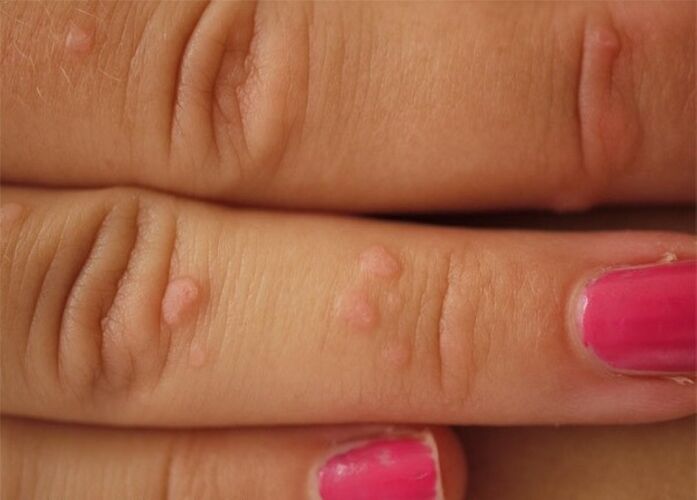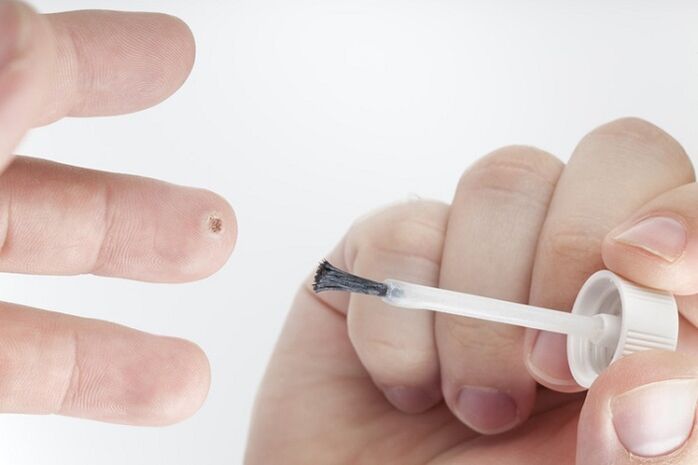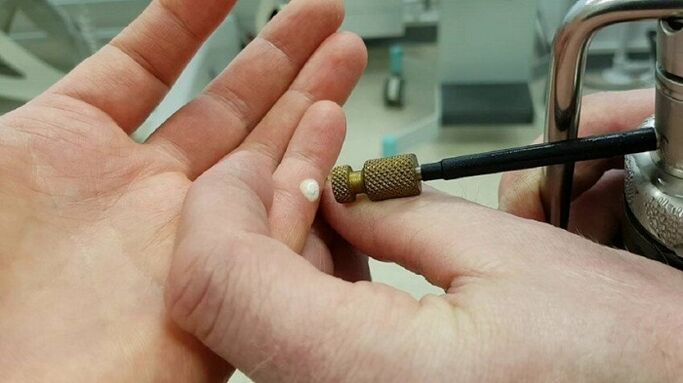As you know, warts are caused by the human papilloma virus. They can be on almost any part of the body, but warts are most commonly found on the hands. When are warts dangerous and need medical attention? How to prevent the appearance of warts on your hands? You will find the answers to these questions in the next article.

Warts on hand
A wart (wart) is a contagious, benign skin lesion that looks like blisters or papillomas.
Flat warts and common warts and genital warts are caused by a common virus that causes them - Tumefaciens verrucarum. The incubation period is long (2-5 months). Histologically, depending on the clinical form, different severity of papilloma, dermatitis, hyperkeratosis were detected; in cells of the styloid layer - the perinuclear vacuole.
A common wart (verruca vulgaris) is a dense, non-inflammatory, spike-to-pea sized nodule, gray or yellowish, with a rough surface. Usually localized on the hand. Common warts can appear in large numbers.
Flat wart, also called wart (verruca plana, s. Juvenilis) - a flattened papule, slightly raised above the level of healthy skin, rounded or polygonal border, flesh-colored or slightly rose-yellow, translucent surface, doublewhen the ball. Flat warts are often many, growing on the face and back of the hands in young people, mainly of school age.
Plantar warts (verruca plantaris) - a callus-like form of common warts - are localized in areas of greatest stress, mainly on the tarsal tips and in the heel region. Pain to pressure. After scraping the horny blocks on the acne surface will reveal papillae.
Warts (condyloma acuminatum) appear as tiny pink papillomas, then grow larger, papilla-shaped. When the papules merge, extensive vegetation is formed. Characterized by soft consistency, narrow foot-shaped sole. Usually develops more on the genitals, in the groin folds and between the buttocks with unclean skin care and maintenance.
Features of warts on hands and palms
Warts can completely affect any part of the cuticle of the hand, but they most often form on the back of the hand or in the finger area. Moreover, most of these formations belong to coarse growths that do not differ in color from healthy skin and are relatively small in size - 0. 1 to 1 cm.
For such a number of tumors, there are both single skin defects and multiple warts prone to fusion.
Signs of warts on the palm of the hand are the following symptoms:
- Relieve pain and itching;
- Defect site on non-epidermal skin, usually restored after wart removal;
- Black dots may appear on the surface of the formation, indicating coagulation vessels.
Based on all the above, we can conclude that palmar warts are a cosmetic defect, however, if not treated in time, can lead to significant proliferation of warts. tumor and high risk of mechanical damage.

How to recognize warts?
Warts look like a raised mass on the skin, different in color from the skin. Usually, several warts appear at the same time. At the same time, the localization can be very diverse: from the palms of the hands, to the face to the soles of the feet (warts). Warts can appear on palms and even under fingernails! To the touch, the shape is rough, or conversely, smooth and flat.
The papillomas appear in groups that are likely to merge.
Warts (common) usually appear on the fingers. The raw wart looks like a tumor no more than one centimeter in size, its color is brown or gray, and is dome-shaped. Black dots can be seen inside the system. Small flat warts often appear on the hands and they are characterized by the appearance of groups. Their color is pinkish or yellowish.
The reason for appearing
Warts on fingers and other parts of the body are a proprietary virus, which is associated with the entry of the human papillomavirus into the patient's bloodstream. Based on this, the treatment of warts on the fingers, palms, and elbows should aim to eliminate the underlying cause. Unfortunately, to date, there is no medical technique capable of completely freeing a patient's blood from the virus, which would rather explain the cancer's symptomatic therapy.
An important concomitant factor that causes the appearance of warts on the hands is a decrease in the body's immune response, which can occur as a result of overwork, malnutrition or infectious processes. Considering the fact that HPV can enter the bloodstream through damage to the epidermis, it is important to note the role of minor wounds, scrapes and minor wounds, which are not uncommon in the skin of the hands. Based on all of the above, you can once again appreciate the importance of personal hand hygiene.
Despite all of the above, HPV infection is not a serious problem. Statistical data confirm that about 90% of all people are carriers of the virus, which can remain dormant for a long time in the blood in a latent state.
As mentioned, these tumors appear due to the entry of the HP virus into the body, there are more than a hundred types. The virus is fairly common, and common warts are found in 20 percent of students.
It's important to remember that the attack multiplies quite strongly - through the sprouting of the upper layers. HPV is especially fond of small cracks in the skin and bacteria, so most of them are "carried" by people from public pools and reservoirs.
If you do not take treatment measures and do not get rid of such rashes, complications can arise: they can spread throughout the body, and even if they disappear, they can recur. return. When removing warts at home, keloids can form.
Symptoms of warts on hands and fingers
Of course, warts, for all their harmlessness, should not be ignored, as they can cause quite a bit of trouble. Furthermore, they are contagious and can be transmitted to new and new victims with a simple touch.
By the way, the appearance of such rashes should be a reason to think about your own immunity, because people with weakened immunity are at risk of contracting the disease. Much stress weakens our immunity, and so such people also become exposed to such a virus.
How to recognize a wart? Around papillae or raised nodules on the skin, the skin will have a characteristic light color or, conversely, a dark color. The bump appears more than one, usually on the forehead, cheeks, arms and legs, appearing as small, dense and fleshy warts that are smooth and flat. Rough lumps that appear around the fingernails or under the fingernails and on the legs, you may also notice lumps that are oval or round in shape and cause pain when stepped on. When touched, they are slightly rough or smooth and flat, they can merge in groups into a lump.
The wart virus can stay dormant in your body for years, and its incubation period can last up to six months, so don't be surprised if they suddenly appear for no apparent reason.
Warts can be different: coarse or common, flat, scalded, as well as fibrous and genital. Common warts are those that appear on the feet and hands, on the elbows and knees, and on the fingers and toes. These are small growths, no more than a centimeter, hard to touch, brown or gray in color. Their shape is usually domed.
The surface of normal or rough may be rough, externally cauliflower-like, inside with distinguishable black dots. Flat types include those up to 5 mm in size, distinguished by their smooth flat surface, as well as being pink, yellowish or light brown. Usually, these pimples appear on the face, but can grow in clusters on the hands or knees.
The most annoying are warts: they cause a lot of difficulty in walking, making it feel as if a pebble has gotten inside a shoe. They are usually quite tough, have a dirty gray color. The type of filaments that grow on the face - around the nose, on the neck, around the mouth. They are elongated and resemble a finger in shape and color.
Warts also include genital warts, also known as genital warts: they develop on the genitals, as well as in the groin and buttocks, and are a direct consequence of an unclean attitude to the body. your body. Outwardly they resemble pink, often fused, rash with a foot-like base.

When to see a doctor?
- if the wart rapidly changes shape, color or all together;
- if the wart has an uneven color;
- if the boundaries of the wart are not clear (in this case, most likely, it is not a wart);
- if the wart is painful or injured continuously (this increases the risk of it mutating into something more serious);
- if the number of warts gradually increases;
- if the wart is bleeding or itchy;
How to remove papillomas on your hands
Warts cause us a lot of discomfort in our daily lives. In conspicuous places, they do not look aesthetically pleasing, with inconvenient localization, they quickly hurt and cause pain. So very often people go to a dermatologist when warts appear. Because of their malignant potential, oncologists are also implicated in warts.
Since the appearance of warts is associated with provoking factors, treatment is often supplemented with the addition of vitamin-mineral complexes, sedatives, and immune-enhancing agents. Otherwise, mechanical removal of papillomas may not give the desired results and after a while, they will start to grow again.
The desire to remove warts on your own sometimes leads to bad consequences. Various folk remedies given by consultants not only cannot get rid of the wart, but also contribute to making it more malignant. You should be extremely careful here. Treatment of warts at home should not use traditional medicine, but must use special drugs bought at the pharmacy.
It's even easier to trust specialists from private clinics. Or make an appointment with a dermatologist, oncology clinic.
Method of removing papilloma
Today, private and public clinics can offer a wide range of methods for wart removal. Before choosing a removal technique, listen to your doctor's recommendations. Your doctor will advise you on the most appropriate intervention based on your individual characteristics. Detail:
- Cryodestruction. . . Suppose to use liquid nitrogen to destroy papillomas. Nitrogen is applied to the wart, usually with an applicator, and the formed area is coagulated within fifteen to twenty seconds. To date, applications have been developed for ease of use at home. They can be purchased for a reasonable price in pharmacies.
- Electrolytic coagulation.Remove the papilloma with a thin metal ring under high-frequency current. Local anesthesia is performed before surgery. Full healing occurs within a week.
- Laser coagulation. . . It is similar to blood clotting, only using a laser instead of an electric current.
- Surgical intervention. . . Under local anesthesia, the wart is removed with a scalpel, the surgical wound site is sutured with cosmetic sutures. It is used only when removing large papillomas.
- Chemical method. . . They are used extremely rarely, because the risk of damaging adjacent tissues is too great.

How to get rid of warts on hands?
A woman's son was only four years old when warts started appearing on his arm. There were so many of them that at the nursery the mother was asked not to take him there. And what they did not do with this misfortune! Doctors recommend burning the wart with acid. But this woman still decided to turn to folk methods to treat warts.
Cut a thuja branch (the size of your palm) into 3–7 mm lengths. Put in a glass jar, for example, hydrogen peroxide, pour in alcohol. Cover and incubate for 12 days, shaking occasionally. After 12 days, open and keep the bottle open for 1-2 days. Then the tincture is ready to use.
You need to dip a cotton ball in a match and apply it to the wart several times a day. Lubrication is recommended up to six times a day. And after such treatment, the wart finally began to disappear from the boy's skin without leaving a trace. However, do not expect immediate results. So the boy's treatment process is quite long. And by the way, tinctures can be stored for a very long time.
Propolis to treat warts on fingers
For a very long time - more than six years - a woman could not get rid of warts on her fingers. She tried burning it with liquid nitrogen, but the wart continued to grow. She even went to the oncologist, because she was starting to think it was a malignancy.
But at the hospital, her fear was not confirmed, and the doctor suggested that she take a piece of propolis the size of a wart, put it in her mouth, and soften it with saliva. Now, in slightly warm water - clean, without any additives - hold a finger with the wart for 30–40 minutes for the wart to soften. After that, you need to wipe your finger and apply propolis on the soft pimple in your mouth.
It must be held tightly with tape for three or four days. According to the lunar calendar, it is best to start removing warts at the full moon and continue until the new moon.
On the day before the new moon, remove the bandage and stop treatment until the full moon, and start again on the day of the full moon.
It was with such folk remedies for warts that she easily got rid of this unpleasant misfortune. If you have smaller warts, you can remove them in one full moon to new moon treatment.
Warts Prevention
Then we know that prevention is easier than cure later. This fully applies to warts. First of all, you must adhere to the basic rules of personal hygiene.
You should not go barefoot in common areas, especially wet places - such as showers, changing rooms, swimming pools; do not abuse such shoes, in which the feet constantly sweat, or at least find the opportunity to dry them qualitatively; Do not unnecessarily touch your own or someone else's warts or objects that the patient has touched you.
You should also pay attention to your general health and especially your immune system - eat a balanced diet and lead a healthy lifestyle.
It will be good if you learn to relax and avoid stress - by doing this you are guaranteed to eliminate not only the possible appearance of warts, but also a wide range of possible diseases.














































































